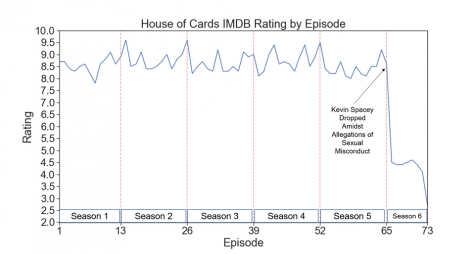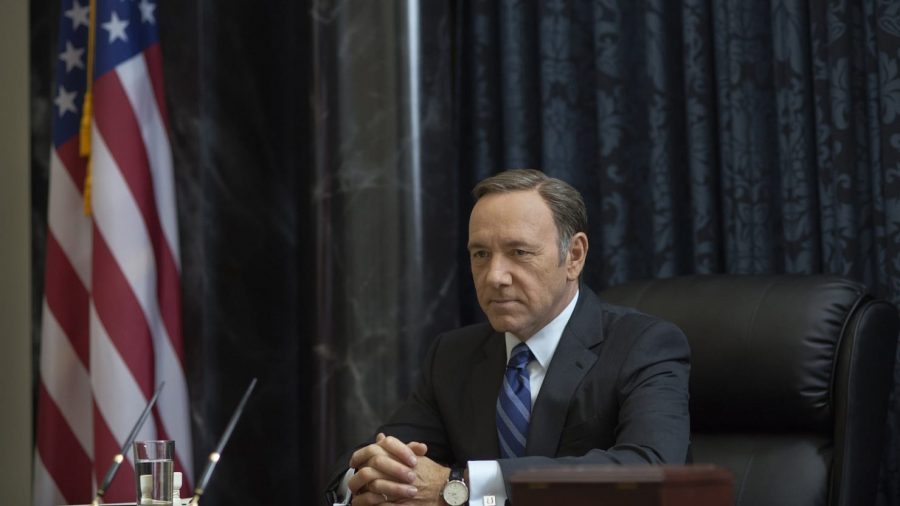Review: The Fall Of The House Of Cards
February 5, 2019
This Article Is Full Of Spoilers. If You Haven’t Seen The Show, I Would Recommend Watching (Some Of) The Show.
Over the course five years, some of us found ourselves immersed in the workings of Washington and the world of the Underwoods. The first season introduces the life of Congressman Francis Underwood (Kevin Spacey) and his role in Congress as the House Minority Whip. Running as a Democrat, F. Underwood would be elected to serve as the representative for the Fifth Congressional District of South Carolina in the 1990 midterms. From there he would go on to win eleven consecutive reelection campaigns, serving in the House until 2013. Another major character we are introduced to is his wife, Claire Underwood, who runs a non profit, the Clean Water Initiative.
As the show progresses we begin to see the Machiavellian Underwood approach to politics. After being passed up as the candidate for Secretary of State under the new Walker administration, a position he had been promised, Underwood begins to execute his plan for revenge. Season one documents his path of utter ruthlessness to reach the office of Vice-President, blazing a trail of deceit, betrayal, and murder to reach his goals. Season two follows Underwood’s tenure as Vice-President. Now serving as second in line, he continues with his plan to reach the top. Showcasing his dark triad personality even more spectacularly than in the first season, Underwood continues to use his skills that seem fit to politics. Season three, four, and five document Underwood’s tenure as President which includes an election in which he wins another four years in the White House, the election of his wife, Claire Underwood, to the position of Vice-President and his (self-implicated) downfall and eventual resignation. Following F.U.’s resignation, Claire ascends to the Presidency and the Underwood dynasty lives on, as Frank once said in the fifth season, “Lucky for them, they have me. They have you. Underwood 2016, 2020, 2024, 2028, 2032, 2036. One nation, Underwood.”
As with many great shows that have come along (I’m looking at you Lost), the quality declines with time. The first program touted to be an “Netflix Original”, Netflix spared no expense when it came to the show. Spending around $100 million alone on the first season spread out over thirteen episodes, the vast budget makes the show stand out from the many other Netflix Original shows that populate the platform. Excellent cinematography, talented actors, complex script-writing, and extensive, detailed sets made the show standout from the first episode. The first two seasons show the Underwoods in their natural setting, plotting and planning two moves in advance to achieve their goals, no matter the consequences. As the Underwoods exploit the powers of the White House (season 3), the show begins to waver. The production quality never slips, but the story-line begins to slide. The White House is not where the Underwoods shine brightest, the path to the Presidency is where we could see the true wrath of the couple. Constantly scheming and maneuvering to achieve their lofty goals. The final destination was arrived at too quickly and it feels as if the writers began to run out of new ideas. Seasons three through five seem mediocre at best when compared to what came before them.

2017 comes around and with it, the sixth season of House of Cards. Or so we thought. That October, reports of accusations against Kevin Spacey emerged. Netflix made the decision to purge Spacey from the series, to scrap what they had filmed of the sixth season, and possibly end the production. After massive outcry for Netflix to complete the series, Netflix commenced a complete rewrite and restarted filming, this time without Spacey. So after months of delay, the sixth and final season was released, touting Robin Wright as the lead character, now serving as the Commander In Chief.
While expectations were low without Spacey starring in the final season, few expected the hot mess that season six would be. All credit to the show creators for pushing out what they were able to, that is, with what they were given. Season six is a mess of plot holes, unnecessary characters, and rushed conclusions (they cut the final season down to eight episodes.) It has the feeling of a train with no locomotive to pull it, only moving because it is rolling downhill. The final season focuses on the Presidency of Claire Underwood, yet it portrays her as someone who needs her husband, which is in no way true. The show documents the shift in society seen over the five years it ran. Transitioning from corruption and nepotism to the era of feminism and “me too”. The importance of our American House of Cards (which is based upon the British House of Cards, a miniseries that aired in the 1990s) can not be understated. It provided an important insight into the world of politics and Washington that can seem so foreign to us today, even though technology has brought more information than ever at a speed never attained before. The sixth season will go down as a stain on the legacy of the show, not because of the characters involved, but because of what Netflix was pushed to release. As can be seen by IMDB’s rating tracker (above), season six brought a steep drop in ratings. If unresolved endings are your style, watching House of Cards in its entirety is for you. Ending on the last episode of season five will leave you just as satisfied as watching the sixth season in it’s entirety.




